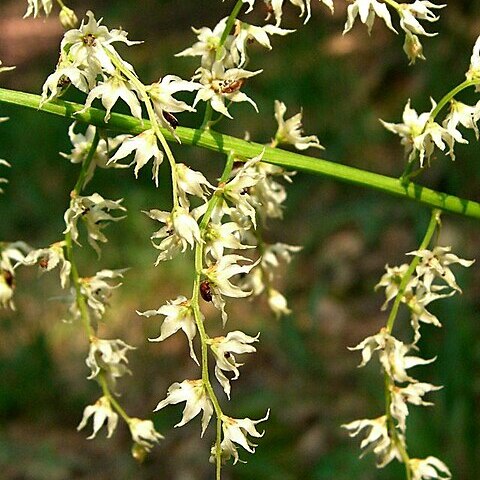Herbs, perennial, from tunicate bulbs and reduced rhizomes; roots fibrous. Stems simple, mostly with 2–3 reduced bracts, glabrous. Leaves mostly basal, reduced distally, spiral, arching downward, sheathing proximally; blade narrowly linear to oblanceolate, strap-shaped, glabrous, apex acuminate or obtuse. Inflorescences terminal, racemose or paniculate, open, bracteate, glabrous. Flowers: proximalmost usually bisexual, distalmost staminate; perianth tubular-campanulate or rotate; tepals persistent, 6, distinct or weakly connate basally, glandular or not, oblong-lanceolate or lanceolate, equal to subequal, apex acute to acuminate; claws absent; tepal glands, when present, 2-lobed, adaxial; stamens 6, distinct or connate basally, equal or subequal; filaments lanceolate; anthers basifixed, 1-locular, obcordate-reniform; pollen sacs apically confluent, extrorse, opening into peltate disc; ovary superior to half-inferior, 3-locular proximally, 1-locular distal to ovules; septal nectaries absent; styles persistent, 3, spreading to recurved, distinct; stigmas minute. Fruits capsular, deeply 3-lobed, membranous, slenderly 3-beaked, dehiscence septicidal, then adaxially loculicidal. Seeds 3–4 per locule, brown to brownish black, narrowly oblong or ellipsoid to lanceoloid, flat, angled to winged. x = 8, 10.
More
Fls perfect or unisexual; tep 6, narrowly lanceolate, long-acuminate, adnate to the ovary-base; stamens 6, much shorter than the perianth, the filaments slender, the anthers obcordate, extrorse, with confluent thecae; ovary superior, ovoid, deeply 3-lobed, each lobe prolonged into a short, stout, outcurved style; capsule 3-lobed, short-cylindric, septicidal; perennial herb, the slender stem bulbous at base; lvs chiefly cauline, linear; infl a terminal white or greenish panicle. Ca 5, N. Amer. and Asia.

